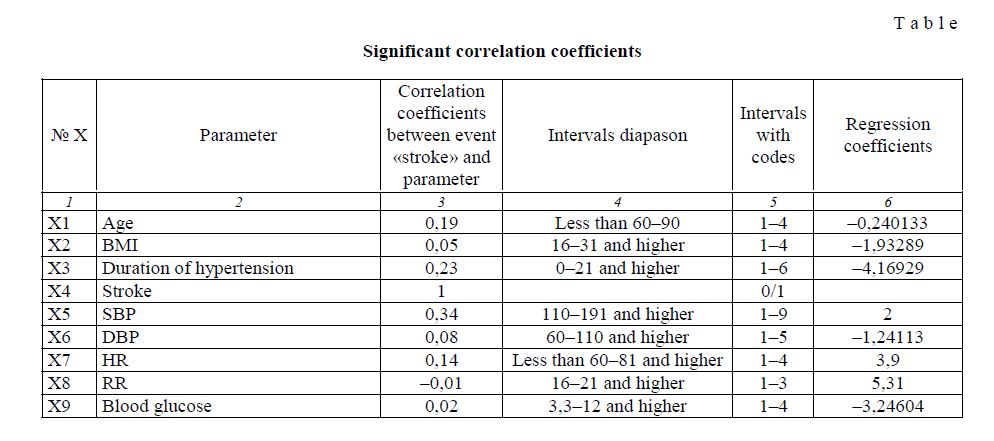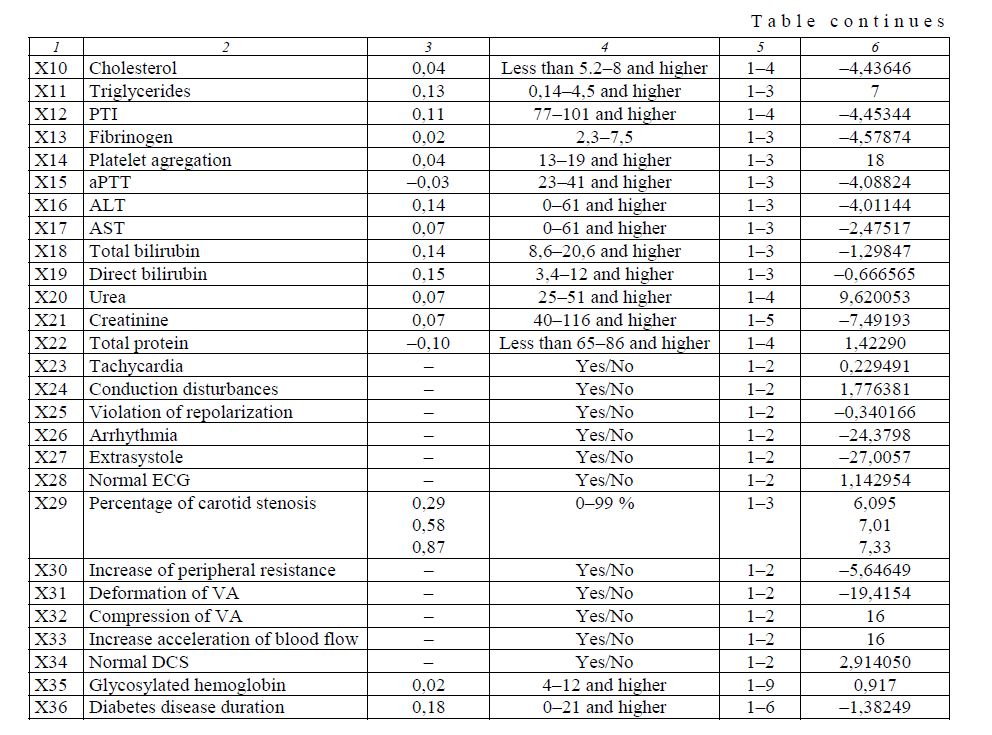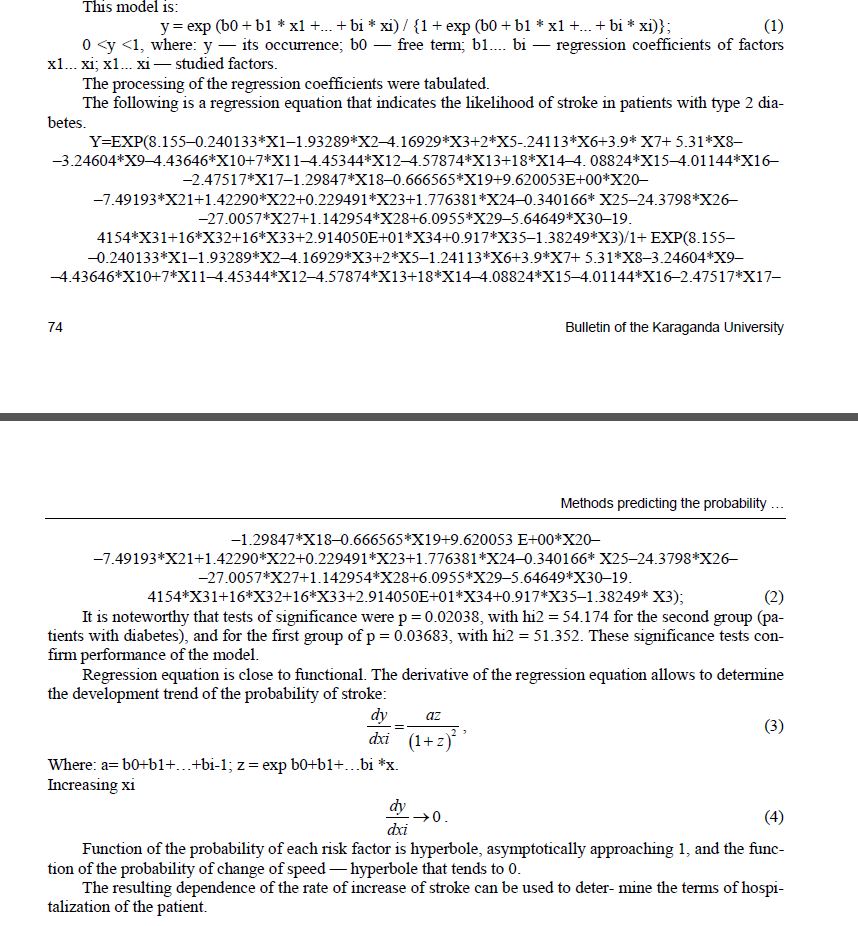Risk developing of a stroke in patients with diabetes 2.8 times is higher comparatively with health persons. Authors proposed the mathematical model «stroke-risk factors» for definition probability of developing of stroke at patients with diabetes 2 types based on standard methods carried out in medical service. The analysis of mathematical model allowed to establish the speed of increase of a stroke for urgent hospitalization of patients.
Introduction
There is a rapid increase in the incidence of diabetes mellitus (DM) now, dominant share of which is type 2 diabetes. Type 2 diabetes is up to 95 % of all cases of diabetes [1]. The significance of this trend is dramatically, not only within manifestation of disease by itself, but also the close pathogenetic association with type 2 diabetes with the development of micro-and macrovascular complications.
Diabetic macroangiopathy is a frequent complication of diabetes with a primary lesion of the coronary, cerebral and peripheral blood vessels. One of the significant pathology that develops on the background of macroangiopathy — an acute cerebrovascular accident (stroke), and encephalopathy as its predecessor. Stroke is one of lea ding causes of death in the world and is the major reason of permanent disability. [2] According to WHO, more than 30 million cases of stroke registered annually [3]. Disability as a result of a stroke varies from 40 to 80 % [4].
According to the MRFIT research the risk of stroke among patients with diabetes was 2.8 times higher than in patients without diabetes. Stroke occurs in 2.08 times mo re frequently in patients with diabetes according to our study [5].
The main theories to explain the development of macroangiopathy in type 2 diabetes include hyperglycemia, dislipidemia, oxidative stress, insulin resistance, hyperinsulinemia, endothelial dysfunction. Difficult to say which mechanism is primary, but it is absolutely clear that they are part of each other and aggravate the disease, accelerating the formation of macrovascular complications [6, 7].
Due to the high risk of stroke in patients with type 2 diabetes it is necessary to carry out preventive measures. It is necessary to develop a method that forecasts the risk of stroke, taking into account possible risk factors to implement an effective prevention of stroke in patients with diabetes.
On the base of Centre of primary health care in Karaganda standard laboratory and hardware methods of investigation were performed. This methods are conducted regularly in patients with type 2 diabetes. A mathematical model predicting the likelihood of stroke in patients with type 2 diabetes was developed according to this data.
The purpose of the study was to develop a mathematical model of «stroke-risk factors» to determine the likelihood of stroke in patients with type 2 diabetes.
Materials and methods
In the laboratory study included 94 participants aged 40 to 83 years, with an equal inclusion of women and men of different national and ethnic origin. There were 60 patients with diabetes mellitus in the compensatory stage with cerebral disorders in the group, 9 of them had a stroke for the current year. The group of comparison consisted of 34 participants with diabetes without stroke matched for age and sex. The criteria for inclusion in the control group were age 40–80 years, normal blood pressure, BMI within 18.5–2.5.
Surveys conducted with all of the participants in the study. The questionnaire presented questions to identify risk factors (gender, age, height, weight, family history of diabetes and stroke, the presence of hypertension and its duration, the presence of diabetes and its duration, smoking, alcohol abuse, lack of exercise, diabetes, unbalanced diet, obesity, emotional stress, use of oral contraceptives), as well as questions that reveal the presence of symptoms of ischemic attacks (sudden headache, nausea, ringing in the ears, dizziness, weakness, loss of consciousness, motor and speech impairment). After conducting the survey all participants underwent the following survey methods.
Measurement of BMI. Body mass index was calculated by Adolph Quetelet formula: I = m/h^2. Measurement of systolic and diastolic blood pressure. The patient was asked to relax and calm down for 15 minutes before measurement. SBP and DBP were measured by the method of Korotkov with mechanical tonometer. Measurement of respiratory rate. Respiratory rate was measured by the auscultatory at rest. Measurement of heart rate. Heart rate was measured by tactile method for a minute at rest. Testing blood glucose blood sampling was performed in the morning on an empty stomach in the standard terms. For blood collection were used tubes Vacutainer, the level of glucose in the blood was determined by the method of Somogyi-Nelson.
Determination of glycated hemoglobin. Blood sampling was performed in the morning on an empty stomach in the standard terms. For blood collection were used tubes Vacutainer. Determination of glycated hemoglobin produced by using immunological reagents Vital and DR 2800 spectrophotometer with a wavelength 443 nm.
Studies of blood coagulation (PTI, amount of fibrinogen, platelet aggregation, APTT). Blood sampling was performed in the morning fasting in the standard terms. For blood collections were used tubes Vacutainer. The analysis was performed on the singlechannel analyzer parameters of hemostasis Clot-1. Determination of blood biochemical parameters (cholesterol, triglycerides, ALT, AST, total bilirubin, direct bilirubin, urea, creatinine, total protein). Blood sampling was performed in the morning fasting in the standard terms. For blood collections were used tubes Vacutainer. For analysis reagents used with the company Vital biochemical analyzer BioSystemA-15.
Electrocardiogram. ECG study was conducted in 12-lead electrocardiograph for BTL-088D, United Kingdom, 2011. CDSM of brachiocephalic trunk. CDSM of b/c the barrel held scanner MEDISON SONOACE X8, 5–12 MHz linear probe.
According to the questionnaires and surveys conducted by expert assessments by specialists (neurologist) was diagnosed with the presence of cerebrovascular accidents. Statistical processing of the measurement was carried out according to conventional methods in the program Statistica. Square correlation matrix was set to determine the correlation coefficient. The distributions of the parameters subordinated to the normal distribution law [8–10].
Results
There is a significant correlation between the event «stroke» and SBP, duration of hypertension, the percentage of stenosis of the carotid artery in the group of patients with diabetes and cerebrovascular disorders. It is interesting to note that there is a significant correlation coefficient between diabetes disease duration and duration of hypertension. Also, there is a significant correlation coefficient between HbA1 and duration of hypertension (Table).
Significant correlation coefficients
T a b l e


It was necessary to create a matrix with coded values to develop mathematical model because these studies included both qualitative and quantitative characteristics in different units of measurement.
The next step is: to determine the regression coefficients by method of logistic regression. These factors were the basis for the development of a mathematical model to predict the risk of stroke [9]. The mathematical model allows: to determine the risk of stroke in a patient or a tendency of stroke rise in social groups, to explore the character of change in the probability of occurrence of stroke according to operating factors, to assess the degree of influence of the studied factors on the probability, to predict the occurrence of stroke for given levels of the factors, to determine the optimal levels of factors to indicate required values of parameters [8].
This model is:

Function of the probability of each risk factor is hyperbole, asymptotically approaching 1, and the function of the probability of change of speed — hyperbole that tends to 0.
The resulting dependence of the rate of increase of stroke can be used to determine the terms of hospitalization of the patient.
Discussion
There are significant correlation coefficients between the event «stroke» and elevated SBP, duration of hypertension and a high percentage of carotid stenosis, the presence of these factors already predetermines the development of cerebrovascular accidents. It takes such a low number of parameters in patients with diabetes for the development of stroke, due to pathologically altered state of the vascular wall, their changed architectonic and endothelial dysfunction.
The glycation end products (GEP) are formed in diabetes. GEP circulating in the bloodstream bind the proteins of the extracellular matrix of blood vessels. In addition, GEP have the following effects: increase permeability between endothelial cells, violate the bioavailability of NO to the smooth muscle cells of arterioles and initiate the secretion of cytokines by macrophages -primary mediators of inflammation [11]. These processes lead to endothelial dysfunction, thickening of the basement membrane, decreased elasticity, increased vascular tone, the violation of their architectonic. According to McDermott, glycosylation end products independently contribute to the development and maintenance of high blood pressure in patients with diabetes mellitus, disrupting normal sensitivity to the action of the vessel walls of vasodilator substances. The irreversibility of the molecules glycosylation end products explains the continued progression of microand macrovascular complications even with very good compensation of diabetes [12].
Violation of NO-producing endothelial function is primarily due to the development of angiopathy and atherogenesis. Inadequate NO production not only leads to reduced vascular relaxation and spasm, but also to an increased vascular permeability of proteins and lipoproteins, to the rapid proliferation of smooth muscle cells to unhindered expression of adhesion molecules on endothelial cells to increased thrombosis. All of these processes lead to an imbalance between vasodilator and vasoconstrictor, prothrombotic and antithrombotic, anti-inflammatory and pro-inflammatory, anti-sclerotic, proliferative factors in side of prevalence the latter [6].
As pointed Mkrtumian [6] et al. alteration of endothelium expresses adhesion molecules, including ICAM-1 to facilitate the penetration of monocytes crowded lipids in the subendothelium. These abnormalities are probably promote lipid accumulation in the vascular wall, proliferation and migration into the intima of smooth muscle cells of arteries and increase their production of collagen and elastin, developing platelet microaggregates. Recent shape the microembolisms vasa-vasorum large arterial vessels with local changes of the vascular wall, which ultimately leads to the development of atherosclerosis and thrombosis.
There are three components of the underlying etiology and pathogenesis of stroke: an inadequate cardiovascular activity, altered state of brain vessels and disturbances in coagulation [13, 14]. The above pathological processes lead to abnormalities in both the cardiovascular system and the inadequacy of blood supply of the brain, atherosclerotic vascular changes and activation of coagulation processes [15–17].
As a result, the long duration of hypertension, high SBP and the high percentage of carotid stenosis in patients with type 2 diabetes are sufficient risk factors for the appearance of stroke.
Conclusions
Obtained results led to the following conclusions about sufficient quantity of three risk factors (elevated SBP, prolonged hypertension, and a high percentage of stenosis of the carotid artery) for the occurrence of acute ischemic attack in patients with type 2 diabetes, due to a significant correlation coefficient between the event «stroke» and examined factors. A methodology was developed to predict the occurrence of stroke in patients with type 2 diabetes. It was based on standard methods regularly conducted in hospitals. The analysis of the mathematical model allowed us to establish the rate of increase of stroke in order to monitor its trend and provide timely hospitalization to the patient.
References
- Gusev E.I. Journal of Neurology and Psychiatry named after Korsakov, 2003, 9, p. 5–7.
- Fedin А.I. Neurological Bulletin, 2005, XXXVII, 1–2, p. 93–104.
- Worldwide organization of health protection: Diabetes, Informative Bulletin, 2012, 312, URL: http://www.who.int/ mediacentre/factsheets/fs312/ru/index.html
- Suslica А., Таnashyan М.М., Ionova V.G. Ischemic stroke: blood, vascular wall, аntitrombotical therapy, Мoscow: Meditsinskaya kniga, 2005, p. 143–151.
- Kаdyrova А. Screening researches of risk of violation of cerebral circulation of blood factors for patients by a diabetes mellitus in the Karaganda area: Dissertation on degree of master of mеdical sciences, Karaganda, 2013.
- Mkrtumyan А.М., Polukarpov М., Stryuk R.I., Davydov А.L. Diabetic маcroangiopatia. Possibility of to the clinic diagnostics, Roszdrav.
- Dedov I.I., Shestacova М.V. Diabetes mellitus, Мoscow: Universum Publishing, 2003, p. 209–222.
- Rebrova О.Yu. Statistical analysis of medical data, Мoscow: Меdia Sfera, 2006, 305
- Kаdyrova I.А., Оspanova K.B., Zhautikova S.B. The method of predicting the probability of stroke in different groups of patients: Certificate of State registration of copyright
- Glanz S. Меdical-biological statistics, Textbook, Мoscow: Praktika, 1998, 459
- Titov V.N., Shiryaeva Yu.K. Clinical Laboratory Diagnostics, 2011, 11, p. 3–13.
- McDermott M.T. Endocrinology Secrets, 2nd ed., Moscow: Binom, 2001, p.
- Symonenko V.B., Shirokov E.A. Preventive cardioneurologia, St. Petersburg: Foliant, 2008, 224
- Symonenko B., Shirokov E.A. Cardioneurologia basics: a guide for doctors, 2nd ed., Moscow: Meditsina, 2001, 240 p.
- Severina A.S., Shestakova M.V. Diabetes mellitus, 2004, 1, p. 62–67.
- Vinik A., ErbasТ., Park Т., Nolan R., Pittenger G. Diabetes Care, 2001, 8, p. 1476–1485.
- Gosk-Bierska I., Adamiec R., Alexewicz P., Wysokinski W. Angiol, 2002, 2, p. 128–133.